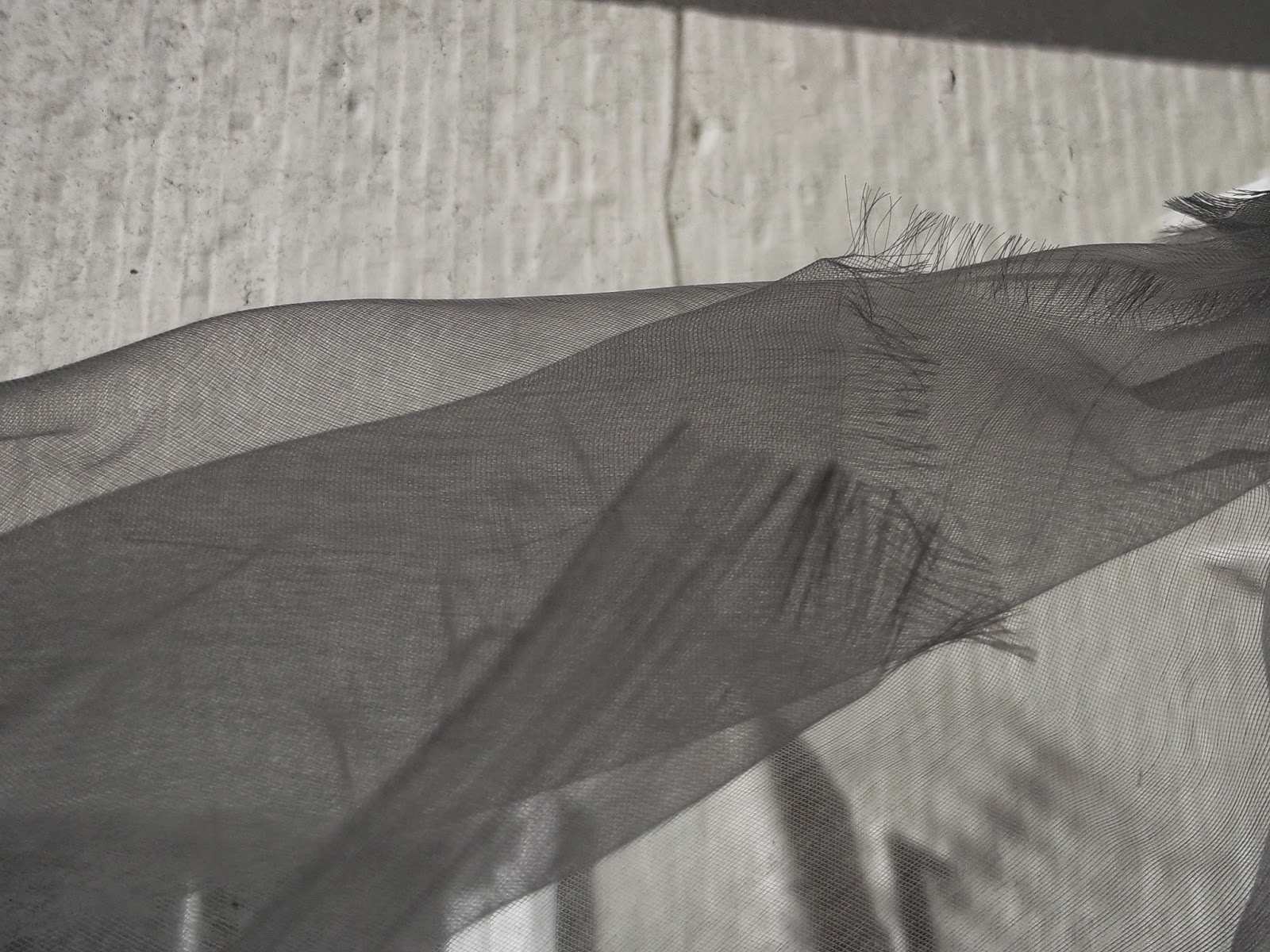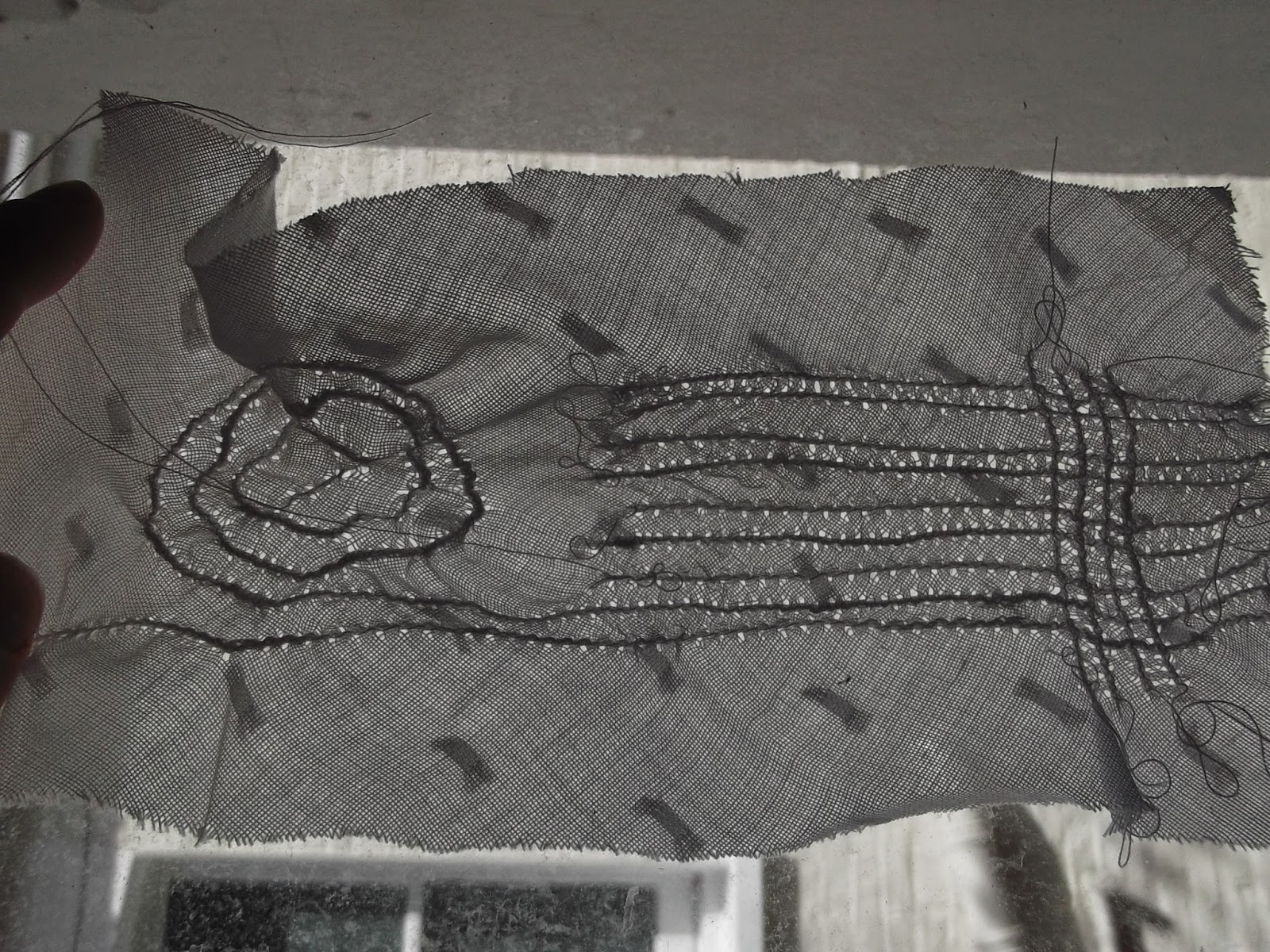The most obvious thing to do with translucent fabric is to make patterns using different numbers of layers of it.
I had kept some filmy grey fabric that had been used as a luxurious wrapping for a bunch of flowers for mother's day. I don't know what it's made of but it has an unusually crisp texture for something almost transparent.
I cut circles in it and overlaid them, holding them up to the light.
At this first stage, i was using tape to keep the circles attached, which adds it's own shadow to the image.
The illusion of texture is interesting, like wood or water, from the reflective qualities of the fabric.
The darker line down the left hand side is the edge of the building outside the window.
The deepest shadow is where the fabric circle folded on itself.
The lightest arcs are where the holes overlap. Against the light like this you can't tell which are holes and which are fabric other than by the lack of texture in the holes.
Not sure how I can use this.
I used silver grey fabric this time. I wondered how it would work with very white lacy fabric.
This is what it looked like against white.
Some hint of texture and lines, but not much interest or contrast.
And here against the window onto my garden. The detail's clear. the colour is slightly less white but there's enough light coming through.
I then tried distorting it with heat.
 Difficult to get the distortion without breaking the fabric altogether (hence the holes.
Difficult to get the distortion without breaking the fabric altogether (hence the holes.The swirliness of the distortions is appealing.
Not very controllable - would take a lot of practice.
Interesting the way three dimensions show in the variations of shadow.
This takes away the clean flatness, but replaces it with hills and valleys.

Putting it against white background again, the whole thing looks darker, and the hills and valleys are less pretty and more dark and menacing.
Trying variations:

I fixed two layers together by ironing a strip of hem fix along the middle. This gives a slight dardening of the shadow, and an interesting texture.
The photo looks out of focus (or more out of focus than it actually is) because of the irregular reflectiveness of the fabric, and the staggered holes.
This was made the same way, but using circles of less translucent fabric to contrast with the grey.
Light shining from the front.
Light shining from behind, with a background of decking. The light coming from behind reveals the lacyness of the bottom circle, which is not visible at all when lit from in front (above). And the overlaps of the lower circles also. But the upper circles don't really show so sharply at all at this intensity of light.
You can see how much diffusion of light there is from the fabric itself by the waves at the top right hand corner.
It would be good to be able to capture that in some way.
Also there is a question in my mind about whether you could make use of the difference of appearance in different light intensitites. Good for a window dressing or lampshade perhaps?
Using shadows and translucent fabrics:
I have used silk painting in the past, and wondered whether the gutta you use to contain the silk paint would increase the amount of light going through the silk. And whether you could get a stained glass effect by shining light through painted silk.
I had also been looking at the way the twilight sky glows behind trees along the road, and wondered if I could somehow capture that contrast between the dark dark trees, and the glowing colours.
 |
| As you can see I wasn't at all successful in that! |
 |
| But when I shone a light through it, the shadow image was sharp and clear, and alsmot completely colourless! |
Finally, I came round to working with bondaweb. I wasn't sure what image to pick, so I went to my reflection photos, and cropped off one pane of a window reflection which looked promising.
The aspects of this image I like, and was hoping to capture, are the subtle colours, including the odd colour of the background; the double images that I assume come from light reflecting off both the front and the back of the glass; and the loopy lines.
This photo doesn't really do justice to the glowingness of the light in real life, and I was hoping to increase that too - not asking much!
This is what it looked like when I had laid out a collage of fabric pieces, and yarns on the pale pink base fabric.
You can see some unspun wool and some cut outs of green organza to give the subtle colour changes to the background.
I wanted the whole thing to be translucent, like the window, so used fabrics which did not block the light completely.
I tested out all the colours against the top yellow layer to ensure that the combined colours would end up more subtle and bright.
This is what it looks like with yellow organza ironed onto the front of it.
The bondaweb for this one was in a whole sheet the size of the sample, so that the whole thing has a similar texture to it.
I'm pleased (and surprised) with how well it turned out, and produced most of the effects I wanted from it. It could be a bit more 'mysterious' in the background, rather than bright, and there were some technical difficulties getting the yarn to lie parallel to itself (but these could be overcome). It has more of a sweeping looping look to it than the pattern on the window, and I like that.













































